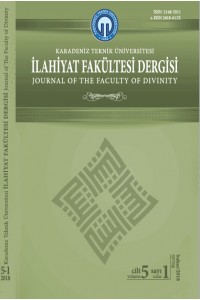Öz
Kaynakça
- Câbirî, Muhammed Âbid. Bünyetu’l-‘aḳlî’l-‘arabî. Mağrib: el-Merkezu’s- Sakafî el-‘Arabî, Dâru’l-Beydâ, 1986.
- Cebecioğlu, Ethem. Tasavvuf Terimleri Sözlüğü. İstanbul: Ağaç Kitabevi Yayınları, 2009.
- Edunîs, Ali Ahmed Saîd. es-Sâbit ve’l-muteḥavvel. 3. Baskı. Beyrut: Dâru’l-‘Avde, 1970.
- Hucvîrî, Ebu’l-Hasen Ali b. Osman. Keşfû’l-maḥcûb. Kâhire: Dâru’t- Turâsi’l-‘Arabî, 1976.
- İbn Arabî, Muhyiddin. ed-Dîvân. Beyrut: Dâru’s-Sâdır, 1969.
- İbn Arabî, Muhyiddin. Fuṣûṣu’l-ḥikem. thk. Ebu’l-‘Alâ ‘Afîfî. Beyrut: Dâru’l-Kitâbi’l-‘Arabî.
- İbn Arabî, Muhyiddin. Iṣtılâhu’ṣ-ṣûfiyye. Beyrut: Dâru’l-Kütübi’l-‘İlmiyye, 2005.
- İbn Arabî, Muhyiddin. Ẕeḫâiru’l-a‘lâḳ fî şerḥi tercümâni’l-eşvâḳ. thk. Muhammed Abdurrahman el-Kürdî. Kâhire: 1968.
- Kuşeyrî. er-Risâletu’l-Ḳuşeyriyye. thk. Abdulhalim Mahmud b. Şerîf.Kâhire: Dâru’l-Kütübi’l-Hadîse.
- Mustafa, Hilmi Muhammed. el-Hayâtu’r-rûhâniyye fi’l-İslâm. Mısır: Dâru İhyâi’l-Kütübi’l-‘Arabiyye, 1945.
- Mübarek, Zeki. et-Taṣavvufu’l-İslâmî fî’l-edeb ve’l-aḫlâḳ. Beyrut: el-Mektebetu’l-‘Asriyye, 2006.
- Necîb, Mahmud Zeki. “Tarîḳatu’r-remz ‘inde Muḥyiddin İbn Arabî”. Kitâbu’t-tizkârî Muḥyiddin İbn ‘Arabî. Kâhire, Dâru’l-Kitâbi’l-‘Arabî, 1969.
- Nicholson. eṣ-Ṣûfiyye fi’l-İslâm. trc. Nuruddin Şerîbe. Kâhire: Mektebetu’l- Hancî, 1951.
- Râdî, Ali Abdulcelîl. er-Rûḥâniyye ‘inde İbn Arabî. Kâhire: Mektebu’n- Nahda.
- Şerhu divâni tercümâni’l-eşvâḳ. haz. Halil İmran Mansu. Beyrut: Dâru’l- Kütübi’l-‘İlmiyye.
- Şerhu divâni tercümâni’l-eşvâk. thk. Muhammed Abdurrahman el-Kürdî. Mısır, 1968.
- Teftazânî, Ebu’l-Vefâ. “el-İdrâku’l-mübâşir ‘inde’ṣ-ṣûfiyye”. Mecelletu ‘ilmi’n-nefs, Külliyetu’l-âdâb, Câmi‘atu’l-Kâhire, 3 (Nisan 1964).
- Tevhîdî, Ebu Hayyân. el-Beṣâir ve’ẓ-ẓehâir. nşr. Ahmed Emin, Ahmed Sakr. Mısır: Lecnetü’t-Te’lîf ve’t-Terceme, 1953.
Öz
Muhyiddin İbn Arabî’nin kendi oluşturduğu lafzî çerçeve aracılığıyla dile bakışı, onu kişi, dil ve dili sorgulama çabası arasındaki ilişkiyi yeniden kurgulamaya sevk etmektedir. Bu, sadece sûfî söylemin eğilimi ve amacını açıkça anlamak için değil, problematiğin genel yapısını da yeniden kurmak içindir. İbn Arabî’nin bu yeni tasavvuru, dinin toplumla ilişkisini gözlemlediği müddet zarfında ortaya koyduğu marifete dayalı soruya dayanmaktadır. Onun bu gözlemleri toplumun siyâsî ve kültürel yönünde olduğu gibi şiirsel tecrübesine ait varlık şekline de uzanmaktadır. Bahsedilen şiirsel tecrübe, sûfî söylemin farklı metin uygulamalarıyla birlikte daha da derinleşmektedir ki İbn Arabî onu daha sonra zaman ve mekânda özel bir çerçeveye nispet edecektir. Fakat o, buna yaratıcı bir şekilde çaba gösterecek yahut ihtimal ve sonsuzluk fikrine dayanmak suretiyle sûfî söylemi bu zaman ve mekâna dirençli kılacaktır.
Anahtar Kelimeler
Kaynakça
- Câbirî, Muhammed Âbid. Bünyetu’l-‘aḳlî’l-‘arabî. Mağrib: el-Merkezu’s- Sakafî el-‘Arabî, Dâru’l-Beydâ, 1986.
- Cebecioğlu, Ethem. Tasavvuf Terimleri Sözlüğü. İstanbul: Ağaç Kitabevi Yayınları, 2009.
- Edunîs, Ali Ahmed Saîd. es-Sâbit ve’l-muteḥavvel. 3. Baskı. Beyrut: Dâru’l-‘Avde, 1970.
- Hucvîrî, Ebu’l-Hasen Ali b. Osman. Keşfû’l-maḥcûb. Kâhire: Dâru’t- Turâsi’l-‘Arabî, 1976.
- İbn Arabî, Muhyiddin. ed-Dîvân. Beyrut: Dâru’s-Sâdır, 1969.
- İbn Arabî, Muhyiddin. Fuṣûṣu’l-ḥikem. thk. Ebu’l-‘Alâ ‘Afîfî. Beyrut: Dâru’l-Kitâbi’l-‘Arabî.
- İbn Arabî, Muhyiddin. Iṣtılâhu’ṣ-ṣûfiyye. Beyrut: Dâru’l-Kütübi’l-‘İlmiyye, 2005.
- İbn Arabî, Muhyiddin. Ẕeḫâiru’l-a‘lâḳ fî şerḥi tercümâni’l-eşvâḳ. thk. Muhammed Abdurrahman el-Kürdî. Kâhire: 1968.
- Kuşeyrî. er-Risâletu’l-Ḳuşeyriyye. thk. Abdulhalim Mahmud b. Şerîf.Kâhire: Dâru’l-Kütübi’l-Hadîse.
- Mustafa, Hilmi Muhammed. el-Hayâtu’r-rûhâniyye fi’l-İslâm. Mısır: Dâru İhyâi’l-Kütübi’l-‘Arabiyye, 1945.
- Mübarek, Zeki. et-Taṣavvufu’l-İslâmî fî’l-edeb ve’l-aḫlâḳ. Beyrut: el-Mektebetu’l-‘Asriyye, 2006.
- Necîb, Mahmud Zeki. “Tarîḳatu’r-remz ‘inde Muḥyiddin İbn Arabî”. Kitâbu’t-tizkârî Muḥyiddin İbn ‘Arabî. Kâhire, Dâru’l-Kitâbi’l-‘Arabî, 1969.
- Nicholson. eṣ-Ṣûfiyye fi’l-İslâm. trc. Nuruddin Şerîbe. Kâhire: Mektebetu’l- Hancî, 1951.
- Râdî, Ali Abdulcelîl. er-Rûḥâniyye ‘inde İbn Arabî. Kâhire: Mektebu’n- Nahda.
- Şerhu divâni tercümâni’l-eşvâḳ. haz. Halil İmran Mansu. Beyrut: Dâru’l- Kütübi’l-‘İlmiyye.
- Şerhu divâni tercümâni’l-eşvâk. thk. Muhammed Abdurrahman el-Kürdî. Mısır, 1968.
- Teftazânî, Ebu’l-Vefâ. “el-İdrâku’l-mübâşir ‘inde’ṣ-ṣûfiyye”. Mecelletu ‘ilmi’n-nefs, Külliyetu’l-âdâb, Câmi‘atu’l-Kâhire, 3 (Nisan 1964).
- Tevhîdî, Ebu Hayyân. el-Beṣâir ve’ẓ-ẓehâir. nşr. Ahmed Emin, Ahmed Sakr. Mısır: Lecnetü’t-Te’lîf ve’t-Terceme, 1953.
Öz
The vision of Muhyiddin Ibn ‘Arabî about the language through the literary framework that he put for himself, invited him to arrange the relationship between the person, language, and the effort to question the language. This is not only to clearly understand the tendency and purpose of Sufi discourse, but also to reconstruct the general structure of the problematic. The new vision of Ibn ‘Arabî is based on the question of knowledge, which he reveals during the period in which he observes the religion's relation to society. His observations are in the political and cultural aspect of the society as well as they stretch through the universal image of the poetic experience which has been firmly established with the various scriptural practices of the sufi discourse which Ibn ‘Arabî ascribes to his own circle of the place and time. But he will try to work creatively on it or being based on this idea of possibility and eternity, he will make sufi discourse resistant to this time and place.
Anahtar Kelimeler
Kaynakça
- Câbirî, Muhammed Âbid. Bünyetu’l-‘aḳlî’l-‘arabî. Mağrib: el-Merkezu’s- Sakafî el-‘Arabî, Dâru’l-Beydâ, 1986.
- Cebecioğlu, Ethem. Tasavvuf Terimleri Sözlüğü. İstanbul: Ağaç Kitabevi Yayınları, 2009.
- Edunîs, Ali Ahmed Saîd. es-Sâbit ve’l-muteḥavvel. 3. Baskı. Beyrut: Dâru’l-‘Avde, 1970.
- Hucvîrî, Ebu’l-Hasen Ali b. Osman. Keşfû’l-maḥcûb. Kâhire: Dâru’t- Turâsi’l-‘Arabî, 1976.
- İbn Arabî, Muhyiddin. ed-Dîvân. Beyrut: Dâru’s-Sâdır, 1969.
- İbn Arabî, Muhyiddin. Fuṣûṣu’l-ḥikem. thk. Ebu’l-‘Alâ ‘Afîfî. Beyrut: Dâru’l-Kitâbi’l-‘Arabî.
- İbn Arabî, Muhyiddin. Iṣtılâhu’ṣ-ṣûfiyye. Beyrut: Dâru’l-Kütübi’l-‘İlmiyye, 2005.
- İbn Arabî, Muhyiddin. Ẕeḫâiru’l-a‘lâḳ fî şerḥi tercümâni’l-eşvâḳ. thk. Muhammed Abdurrahman el-Kürdî. Kâhire: 1968.
- Kuşeyrî. er-Risâletu’l-Ḳuşeyriyye. thk. Abdulhalim Mahmud b. Şerîf.Kâhire: Dâru’l-Kütübi’l-Hadîse.
- Mustafa, Hilmi Muhammed. el-Hayâtu’r-rûhâniyye fi’l-İslâm. Mısır: Dâru İhyâi’l-Kütübi’l-‘Arabiyye, 1945.
- Mübarek, Zeki. et-Taṣavvufu’l-İslâmî fî’l-edeb ve’l-aḫlâḳ. Beyrut: el-Mektebetu’l-‘Asriyye, 2006.
- Necîb, Mahmud Zeki. “Tarîḳatu’r-remz ‘inde Muḥyiddin İbn Arabî”. Kitâbu’t-tizkârî Muḥyiddin İbn ‘Arabî. Kâhire, Dâru’l-Kitâbi’l-‘Arabî, 1969.
- Nicholson. eṣ-Ṣûfiyye fi’l-İslâm. trc. Nuruddin Şerîbe. Kâhire: Mektebetu’l- Hancî, 1951.
- Râdî, Ali Abdulcelîl. er-Rûḥâniyye ‘inde İbn Arabî. Kâhire: Mektebu’n- Nahda.
- Şerhu divâni tercümâni’l-eşvâḳ. haz. Halil İmran Mansu. Beyrut: Dâru’l- Kütübi’l-‘İlmiyye.
- Şerhu divâni tercümâni’l-eşvâk. thk. Muhammed Abdurrahman el-Kürdî. Mısır, 1968.
- Teftazânî, Ebu’l-Vefâ. “el-İdrâku’l-mübâşir ‘inde’ṣ-ṣûfiyye”. Mecelletu ‘ilmi’n-nefs, Külliyetu’l-âdâb, Câmi‘atu’l-Kâhire, 3 (Nisan 1964).
- Tevhîdî, Ebu Hayyân. el-Beṣâir ve’ẓ-ẓehâir. nşr. Ahmed Emin, Ahmed Sakr. Mısır: Lecnetü’t-Te’lîf ve’t-Terceme, 1953.
Ayrıntılar
| Birincil Dil | Türkçe |
|---|---|
| Konular | Din Araştırmaları |
| Bölüm | Çeviri |
| Yazarlar | |
| Yayımlanma Tarihi | 30 Haziran 2018 |
| Yayımlandığı Sayı | Yıl 2018 Cilt: 5 Sayı: 1 |


